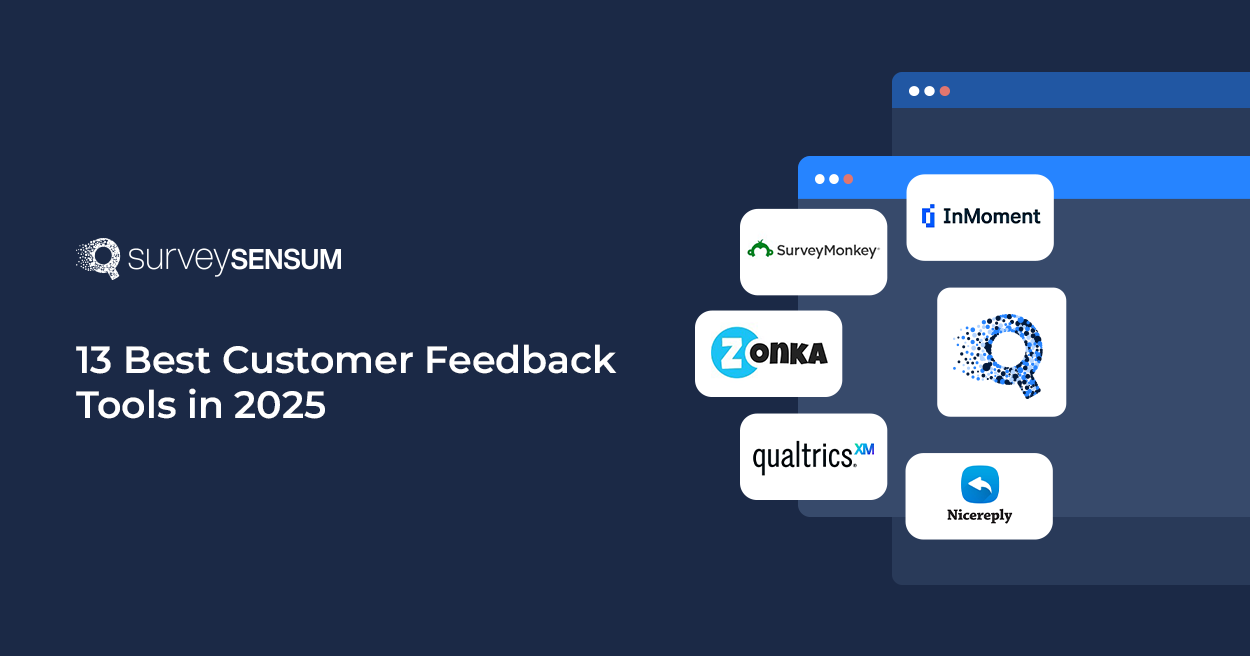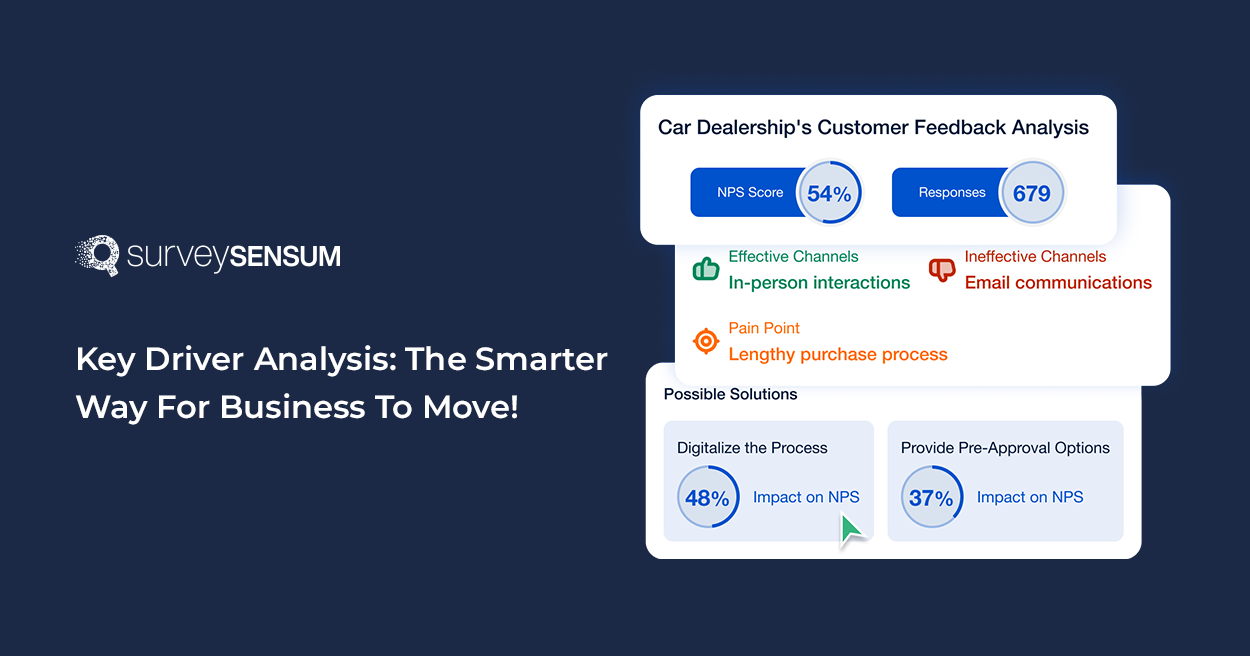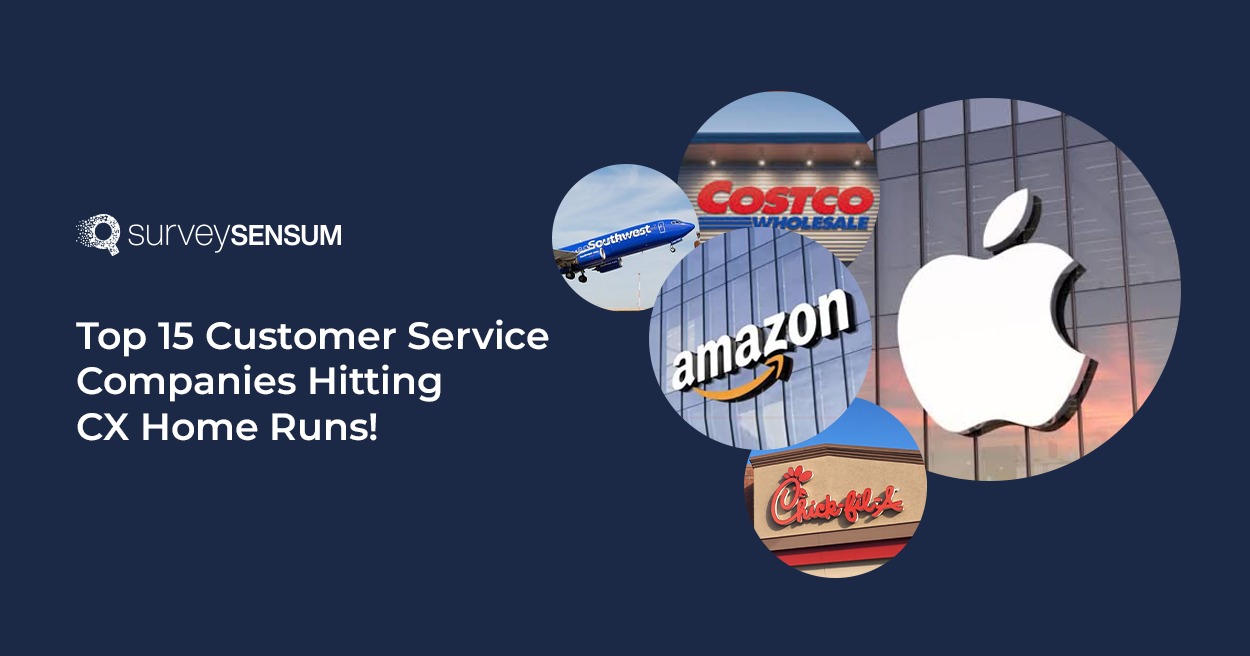
Surveys, embedded in a web application, yield as high as 60%-70% response rates!
Such huge numbers, right?
This high level of engagement provides businesses with a wealth of valuable data to enhance decision-making processes. You see, these surveys aren’t just about randomly pestering visitors. They’re vital for boosting customer engagement and helping businesses demonstrate their commitment to listening to their audience and delivering personalized experiences.
So, if you’re on the fence about whether these popup surveys are worth the effort, stick around.
Let’s discuss what popup surveys are, why they are at better conversion than other survey methods, and some best practices to create the best popup survey designs.
So, let’s start by understanding popup surveys.
What is a Popup Survey?

A popup survey is a type of online survey, designed with a survey builder tool, that appears in a popup window or overlay on a website or within a mobile application.
Unlike traditional surveys sent via email or WhatsApp, capturing customer feedback with pop up surveys happens in real-time. These surveys can be triggered based on various criteria, such as time spent on a webpage, specific actions taken by the user, or upon exit intent.
But, why are pop-up surveys important for businesses and what are its benefits?
What are the Benefits of Popup Surveys?
Popup surveys offer a plethora of benefits for businesses looking to understand their customers better and improve their offerings. Here are some of the key benefits of popup surveys:
1. High Engagement
Popup surveys capture higher response rates compared to other survey methods. Their timely appearance on a website or within an app catches users’ attention while they are actively engaged, increasing the likelihood of participation.
2. Real-time Feedback
Popup surveys capture feedback exactly when customers are engaged with the product and this provides businesses with real-time insights into customer opinions, preferences, and pain points.
3. Improved User Experience
Popup surveys help businesses identify areas for improvement in the user experience. By understanding customer frustrations, and challenges, businesses can make necessary improvements.
4. Targeted Insights
Popup surveys are strategically targeted to specific user segments or behaviors. This allows businesses to gather insights from relevant audiences and tailor their offerings accordingly, leading to more personalized experiences.
5. Cost-effectiveness
Compared to traditional market research methods, such as focus groups or phone surveys, popup surveys are often more cost-effective to implement. They require minimal resources and can be easily integrated into existing digital platforms.
Now that we understand the benefits of popup surveys, let’s give some examples and types of popup surveys.
Popup Survey Examples [Along With Brand Examples]
Here are some popup survey examples along with brand examples:
1. Customer Satisfaction Survey Popup
Brands display customer satisfaction popup surveys after a customer completes an interaction like a purchase or creating an account, etc, asking them to rate their overall satisfaction with the product/service.
Brand Example: Jira often utilizes popup surveys to gather feedback from users about their experience with the product. For example, it asks users to rate their experience with publishing a page using their product and what they can do to improve it.

2. NPS Survey Popup
Businesses display website popup surveys asking users to rate their likelihood of recommending the product to a friend or colleague. This helps the business to gauge customer loyalty and the likelihood of recommending the product or service. Also, by asking an open-ended question with the NPS question, you can ask customers to elaborate on their experience and talk about ways to improve the product.
Brand Example: Google Meet frequently uses popup surveys to measure its users’ likelihood to recommend the platform to others, helping them gauge customer loyalty and satisfaction.

3. Exit Intent Survey Popup
Businesses trigger a popup survey when a visitor shows intent to leave the site, asking for reasons why they didn’t make a purchase. This helps you understand why visitors are leaving the website without completing a desired action, such as making a purchase.
Brand Example: Lowe’s employs exit popup surveys to gather feedback from users who abandon their carts, enabling them to identify potential barriers to conversion and make improvements to their website or product.

4. Website Feedback Survey Popup
Businesses display a popup survey asking users for feedback on the site’s layout, content, and navigation. This helps you to gather feedback on website design, content relevance, navigation ease, and overall user experience.
Brand Example: Norton presents popup surveys to its users, seeking input on various aspects of their digital experience, which helps them continually refine their product.
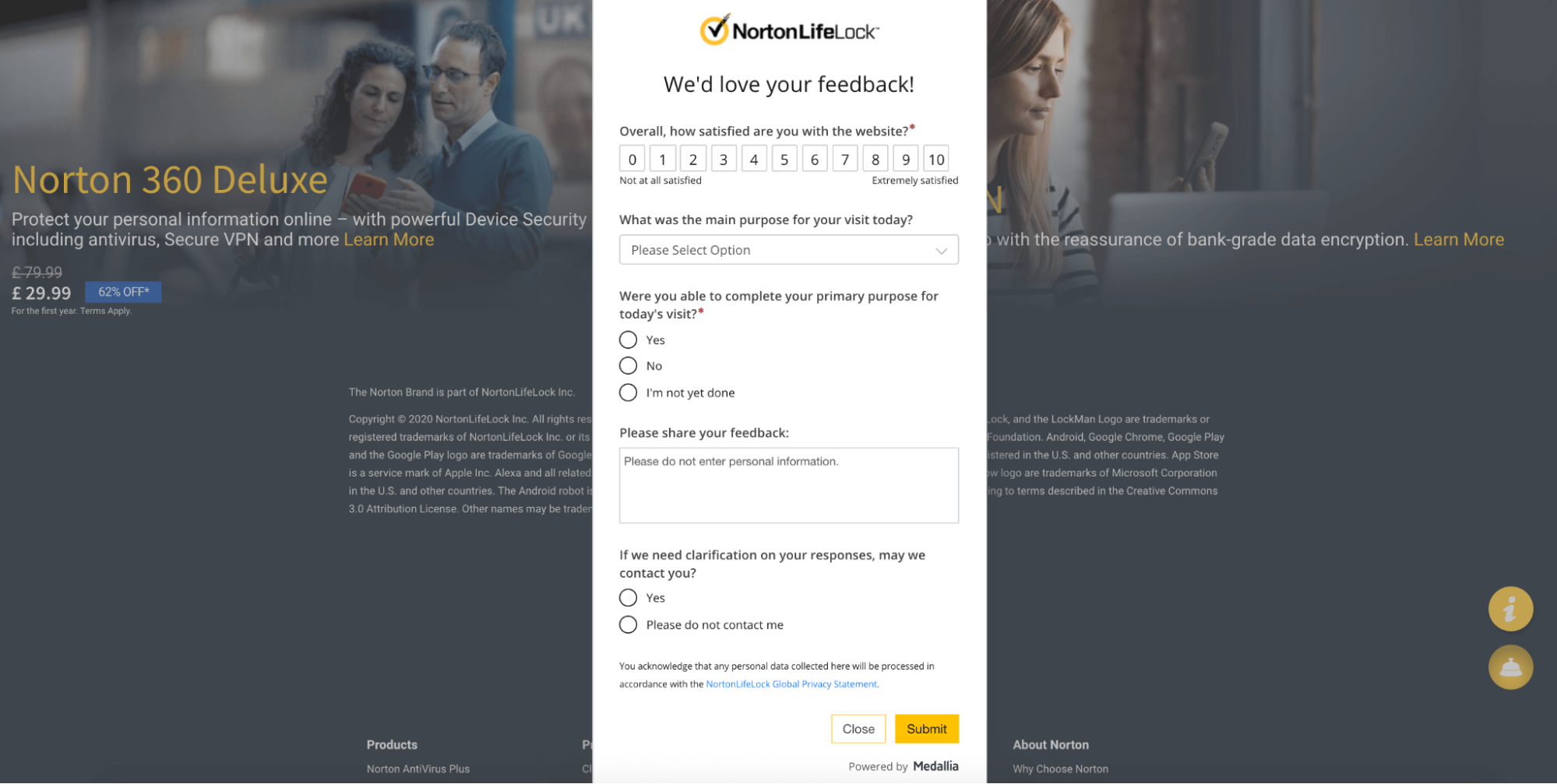
5. Product Feedback Popup
Businesses with mobile apps show popup surveys to users after they complete a specific task within the app, asking for feedback on new features, usability, or overall experience. It helps prioritize feature development, identify bugs or usability issues, validate product enhancements, and ensure alignment with user needs and preferences.
Brand Example: Google Sheets uses popup surveys within its app to gather product feedback on new features, overall satisfaction, and user preferences, allowing them to tailor the app experience to their audience’s preferences.

6. Customer Support Satisfaction Survey Popup
Businesses use website popup surveys or in-app pop up surveys after a customer interacts with a support agent, asking for feedback on the resolution process. This enables businesses to identify areas for improvement in customer support, address recurring issues, enhance response times, and ultimately improve customer satisfaction and retention rates.
Brand Example: BookMyShow utilizes popup surveys to gather feedback from customers after they’ve interacted with their support team, helping them continuously improve their service delivery and customer satisfaction levels.

These popup survey examples illustrate the diverse ways in which brands leverage popup surveys to gather valuable insights from their customers, enhance their user experience, and drive business growth.
Gather and analyze customer feedback with SurveySensum in real time to boost the overall customer experience while driving CX-driven ROI.
So, now we know the different types of popup surveys to use, let’s discuss some of the best popup survey questions to ask and when to ask them.
Best Popup Survey Questions To Ask [And When to Ask Them]
Crafting effective pop-up survey questions involves considering the timing, relevance, and clarity of the questions to ensure valuable insights are gathered from respondents. Here are some of the best popup survey questions to ask along with the most appropriate times to ask them.
1. Customer Satisfaction Survey
- How satisfied are you with your recent experience on our website/service?
- What aspects of your experience did you find particularly satisfying?
- How likely are you to return to our website in the future?
Timing: Trigger the popup after a customer completes a purchase, signs up for a service, or interacts with a specific feature.
2. NPS Survey
- On a scale of 0 to 10, how likely are you to recommend our product/service to a friend or colleague?
- What is the primary reason for your score?
- Is there anything else you’d like to share about your experience with us?
Timing: Trigger after a user completes a transaction, interacts with customer support, or achieves a milestone within the product.
3. Exit Intent Survey
- What stopped you from completing your purchase today?
- Was there a particular aspect of our website that didn’t meet your expectations?
- Is there any feedback you’d like to provide before you leave?
Timing: Launch when a visitor is about to leave the website without completing a desired action, such as making a purchase or signing up.
4. Website Feedback Survey
- How easy was it to find the information you were looking for on our website?
- Are there any features you would like to see improved?
- Would you recommend our website to others based on your experience today?
Timing: Trigger after a user spends a significant amount of time on the website or when they attempt to navigate away from a particular page.
5. Product Feedback Survey
- Which features of our product do you find most useful?
- How satisfied are you with the overall performance of our product?
- How likely are you to continue using our product in the future?
Timing: Show after a user interacts with a new feature or completes a specific task within the product.
6. Customer Support Satisfaction Survey
- How satisfied are you with the assistance you received from our support team?
- Did our support team address your issue?
- Was the response time from our support team satisfactory?
Timing: Display after a customer concludes an interaction with the support team, such as closing a support ticket or ending a live chat session.
Gather and analyze customer feedback in real-time with SurveySensum’s industry-specific survey templates.
These questions, when strategically deployed in popup surveys, can provide valuable insights into customer satisfaction, loyalty, user experience, and areas for improvement. Now that we know what type of popup survey to use, what questions to ask, and when to launch them, let’s explore some best practices for popup surveys.
Best Practices To Create Popup Survey
Here are some best practices for popup surveys:
1. Define Clear Objectives
Clearly define the purpose and goals of your survey. Determine what specific insights you hope to gain and how you plan to use the data collected to improve your products, services, or customer experience.
2. Keep it Short and Relevant
Limit the number of questions to prevent survey fatigue and increase completion rates. Focus on asking only the most relevant questions that align with your survey objectives.
3. Use Clear and Concise Language
Use simple, easy-to-understand language in your questions to ensure clarity and minimize confusion.
4. Offer Incentives
Consider offering incentives such as discounts, freebies, or entries into a prize draw to encourage participation. However, ensure that the incentive is relevant to your audience.
5. Design an Eye-Catching Popup
Design the popup survey to be visually appealing and attention-grabbing without being intrusive. Use engaging visuals, compelling copy, and clear calls to action to encourage participation.
6. Choose the Right Timing
Trigger the popup survey at appropriate moments during the user’s interaction with your website or app. Consider factors such as time spent on the page, specific actions taken, or exit intent to determine the optimal timing.
7. Offer an Opt-Out Option
Provide users with the option to easily dismiss or opt out of the survey if they prefer not to participate.
8. Ensure Mobile Responsiveness
Given the prevalence of mobile usage, ensure that your popup survey is fully responsive design and displayed correctly on various mobile devices.
9. Make It Easy To Close
Not everyone wants to provide feedback which can make pop-up surveys a bit intrusive, especially if the surveys are not easy to close and keep appearing again and again after the user has disabled them repeatedly. This can lead to frustration and a negative user experience. So, provide a visible and accessible close button so users can opt-out without feeling trapped.
Use these best practices to create effective popup surveys, let’s now see some common mistakes that you need to avoid in pop-up surveys.
Common Mistakes to Avoid in Pop-Up Surveys
Here are some mistakes that businesses make while designing and launching pop-up surveys, so let’s discuss them and how to avoid them.
1. Overloading Users with Too Many Questions
Pop up surveys are meant to be quick and provide real-time feedback so asking too many questions can result in survey fatigue, survey abandonment, etc. So, ask relevant questions that can provide quick actionable insights.
For example, for website feedback, ask questions like “Are you finding the information you were looking for?” or “Please rate your experience with the website”. Limit your survey to 2-3 questions and keep it around your business objective.
2. Poor Timing and Frequency
Timing is everything when it comes to pop-up surveys. Triggering them too early in the customer journey or showing them repeatedly can disrupt the experience and lead to dissatisfaction. Use behavior-based triggers, like showing the survey after a purchase or when the user spends a certain amount of time on a page.
For example, after a user is done with a purchase, trigger a pop up survey asking “Please rate the purchase experience on our website.” Don’t show it during the transaction as it would disrupt the experience and prompt them to give a negative rating or completely ignore it.
3. Ignoring Mobile Users
With a significant portion of users accessing websites via mobile devices, failing to optimize surveys for smaller screens is a missed opportunity. Ensure your pop-up surveys are mobile-friendly, load quickly, and are easy to navigate on touchscreens.
So, ensure your surveys are responsive and adapt seamlessly to different screen sizes, test your pop-ups on various devices before launching, use larger, touch-friendly buttons, and keep text concise to enhance readability.
How’s your checkout experience? Are your users finding it easy to navigate? Gather data with SurveySensum’s pop up surveys in real-time and take relevant action promptly!
Let’s now see some alternatives to popup surveys and see their pros and cons and why popup surveys are better.
Why Consider a Popup Survey Rather Than Its Alternatives?
There are a few alternatives to popup surveys, but popup surveys are the better choice for gathering real-time feedback. Let’s discuss the pros and cons of these alternatives and what makes them unsuitable for your business.
1. Feedback Buttons
These are clickable elements placed on a website or within an app, allowing users to express their opinions or sentiments with a single click.
Pros:
- Feedback buttons are unobtrusive and don’t disrupt the user experience.
- Buttons can be placed strategically throughout a website or app, allowing users to provide feedback at any time.
Cons:
- Feedback buttons often provide only binary feedback (e.g., thumbs up/thumbs down), offering limited insight into user opinions or preferences.
- Without accompanying comments or explanations, it can be challenging to understand the reasons behind user feedback.
2. Live Chat Surveys
These surveys involve engaging with users in real time through a chat interface, allowing for personalized interactions and immediate feedback.
Pros:
- Live chat surveys offer real-time, personalized engagement with users, fostering a sense of connection.
- Users can ask questions or seek clarification during the survey, leading to more accurate responses.
Cons:
- Live chat surveys require staff or automated systems to manage and respond to inquiries, which may not be feasible for all types of businesses.
- Users may not always be available or willing to engage in live chat surveys, limiting the opportunities for data collection.
3. Email Surveys
These surveys involve sending survey invitations via email to collect feedback from recipients.
Pros:
- Email surveys can help reach a large audience quickly and cost-effectively, especially for businesses with established email lists.
- Email surveys include various survey question types and formats, allowing for detailed feedback collection.
Cons:
- Email surveys often suffer from low response rates, especially in comparison to popup surveys, due to inbox clutter, spam filters, and user fatigue.
- Responses to email surveys may be delayed, leading to less timely insights compared to real-time methods.
4. SMS Surveys
These types of surveys involve sending survey invitations via text message to collect feedback from recipients.
Pros:
- SMS surveys are delivered instantly to users’ mobile devices, enabling immediate feedback collection.
Cons:
- SMS messages have character limits, restricting the length and complexity of survey questions.
- Users must opt-in to receive SMS surveys, limiting the potential audience compared to other channels.
5. Phone Surveys
These types of surveys involve conducting surveys over the phone with respondents, typically through scripted interviews or questionnaires.
Pros:
- Phone surveys allow for direct, personalized interaction with respondents, facilitating in-depth conversations and clarifications.
Cons:
- Phone surveys can be time-consuming and resource-intensive, requiring trained staff to conduct interviews and record responses.
- Phone surveys can be expensive to implement, particularly for large-scale surveys or surveys targeting diverse demographics.
While each survey method has its pros and cons, popup surveys offer immediate feedback, high visibility, and increased response rates, making them a compelling option for businesses seeking timely insights from their audience. However, the data is only valuable if you analyze the data properly and take relevant action on it.
How to Analyze Pop-Up Survey Data?
Pop up surveys are indeed a valuable source of information. However, the real value of this data lies in careful analysis to uncover trends and ultimately take the right action. So, here’s a step-by-step guide on how you can analyze your pop up survey data effectively.
- Gather Feedback From Multiple Channels: Relying solely on pop-up surveys can limit your understanding of the customer experience. To get a comprehensive view, integrate feedback from various sources such as email surveys, in-app surveys, social media reviews, etc. This approach ensures that no data is missed, providing a holistic and unified view of the customer journey.
- Leverage AI for Text Analysis: Analyzing feedback can be time-consuming, especially when dealing with open-ended feedback. Opt AI survey tools that leverage AI, machine learning models, and automation to extract recurring themes, identify trends, and categorize feedback into actionable insights, uncovering hidden patterns that might go unnoticed during manual analysis.
- Reporting Capabilities: Once the data is analyzed, analytical dashboards play a crucial role in visualizing insights and aligning your team. Dashboards consolidate data into intuitive charts and graphs, making it easier to track key CX metrics. They also facilitate collaboration by providing clear reports that can be shared across teams.
- Take Relevant Action: Once you’ve identified trends and issues, prioritize actions based on their impact on customer satisfaction and business goals. Address critical pain points immediately and close the feedback loop by communicating changes to your customers.
Now, let’s understand the step-by-step process of how to create popup surveys.
How to Create Pop-up Surveys?
Here’s how to create pop-up surveys with the SurveySensum survey builder.
- Log in to SurveySensum’s survey builder and create your survey with industry-based survey templates that create surveys in under 5 minutes.
- After the survey is created, click on the “Share” tab.
- Now, click on the “Embed in a website and mobile” option.
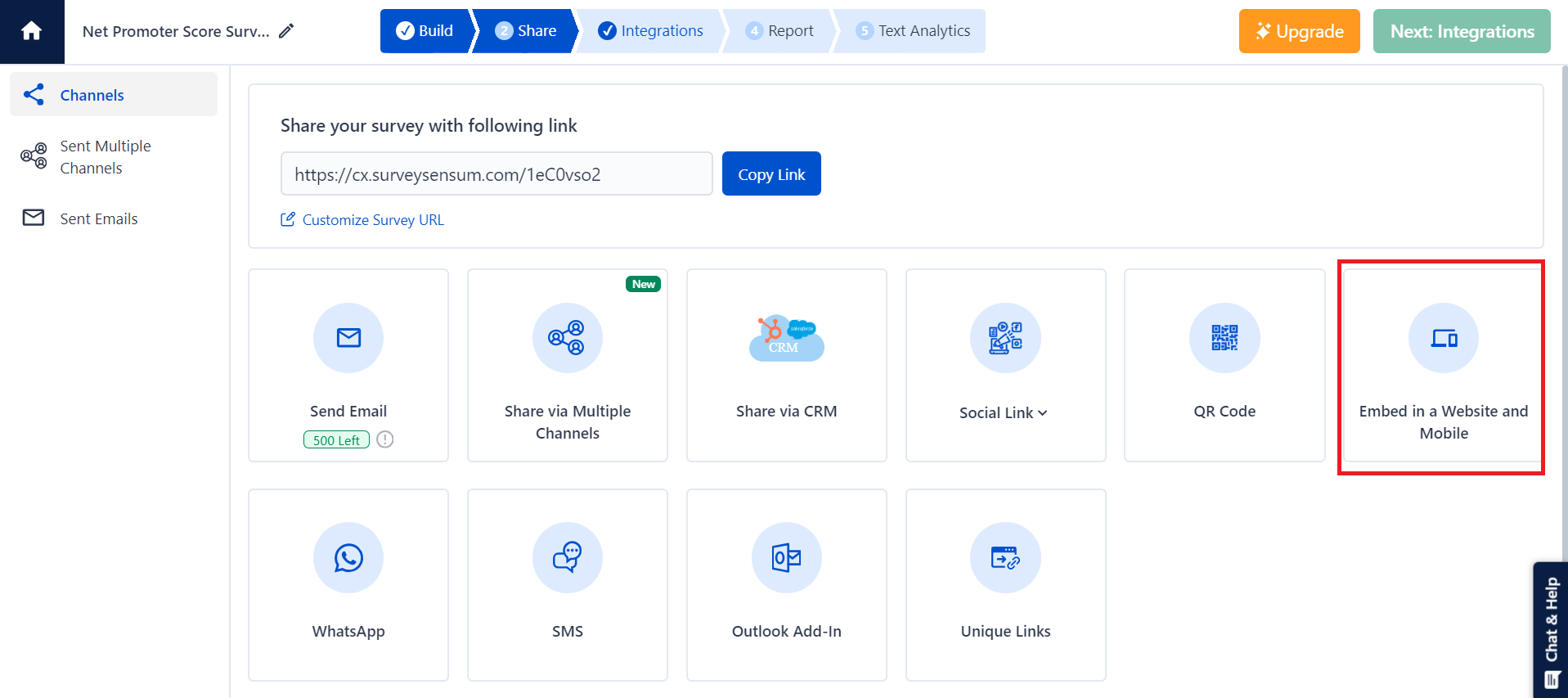
- Here, you can choose between a website, Android, and iOS, depending on within which platform you want to embed the survey.
- After you have chosen the channel you want to embed the survey, you can customize the look of your survey.
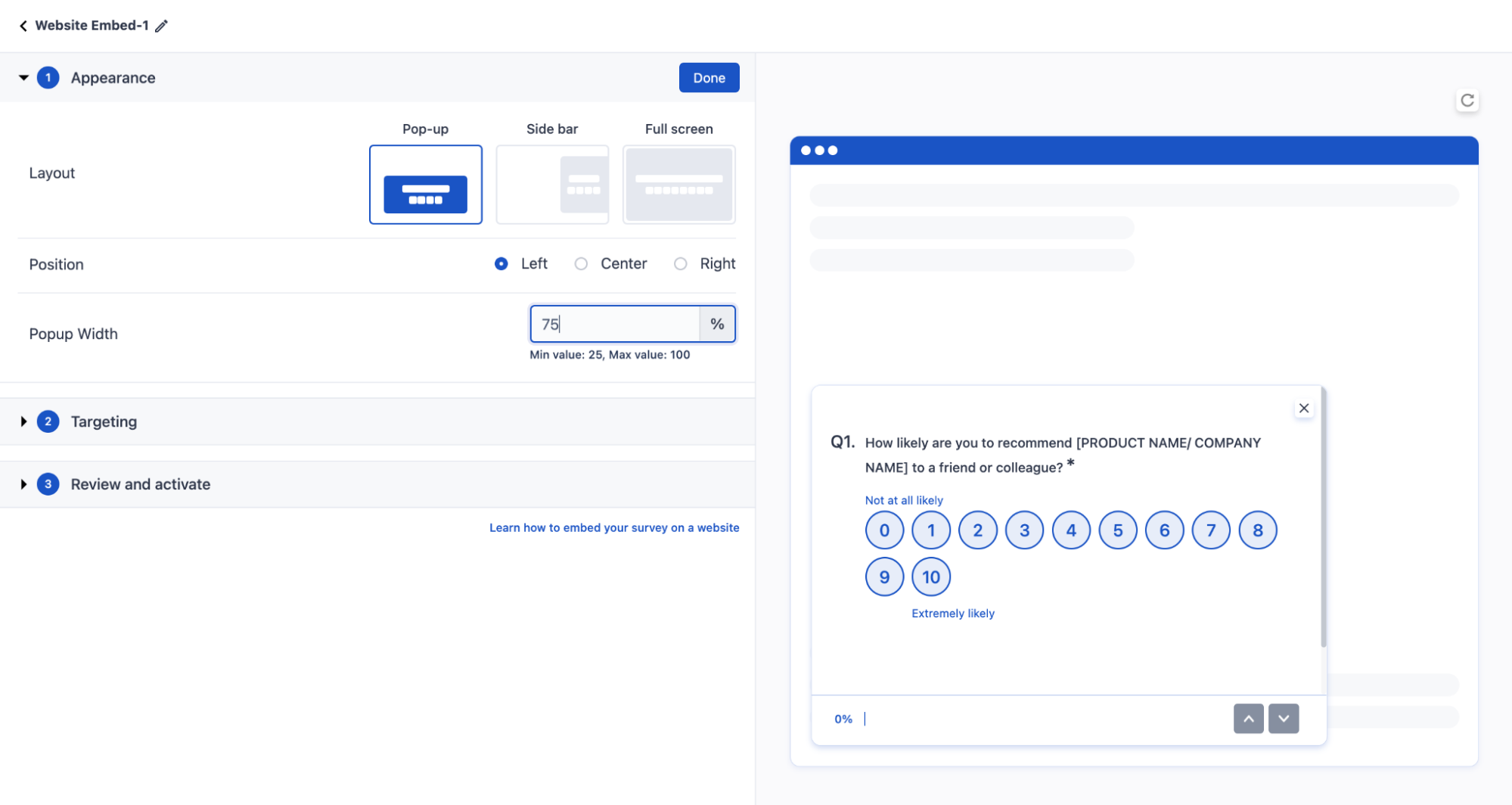
- For the pop-up survey, you can choose any of the three alignments – left, right, or center.
- Now the next step is to choose when, where, and how often you want to pop up the survey to your users. You can either display the survey on a URL or trigger a survey after a user performs an action using Javascript Trigger.
- If you want to display a survey on a URL, choose between 4 operators and enter the value of the URL.
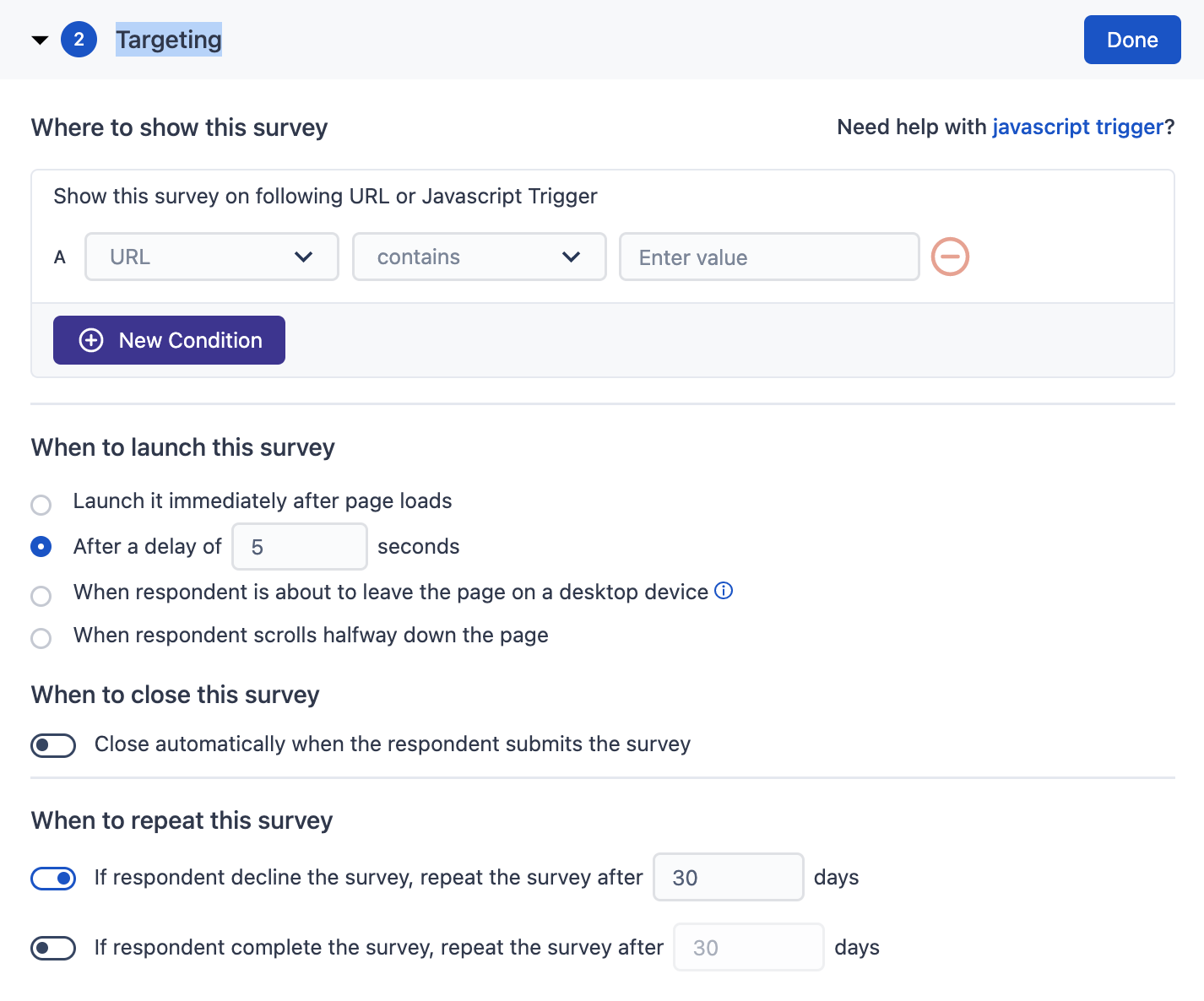
Here is how you can use these four operators.
- Exact match: Targets a specific URL, including HTTP or HTTPS. For example, if you have to target a URL, enter the exact value: https://www.surveysensum.com. If you just specify surveysensum.com it will not match the condition.
- Starts with: Target all pages that start exactly with the URL you specify. For example, if you specify the URL – https://www.surveysensum.com it will match all pages that start with that URL, like https://www.surveysensum.com/product
- Ends with: Target all pages that have a URL that ends in the entered value you specify; Value- /product will match all pages like www.surveysensum/product
- Contains: Target all pages where the URL contains the text you specify. Text: The product will match all pages where the URL contains the product like www.surveysensum.com/product/NPS.
- Finally, check what the triggers are also the appearance you have applied and activated in your embedding by turning the embedding ON.
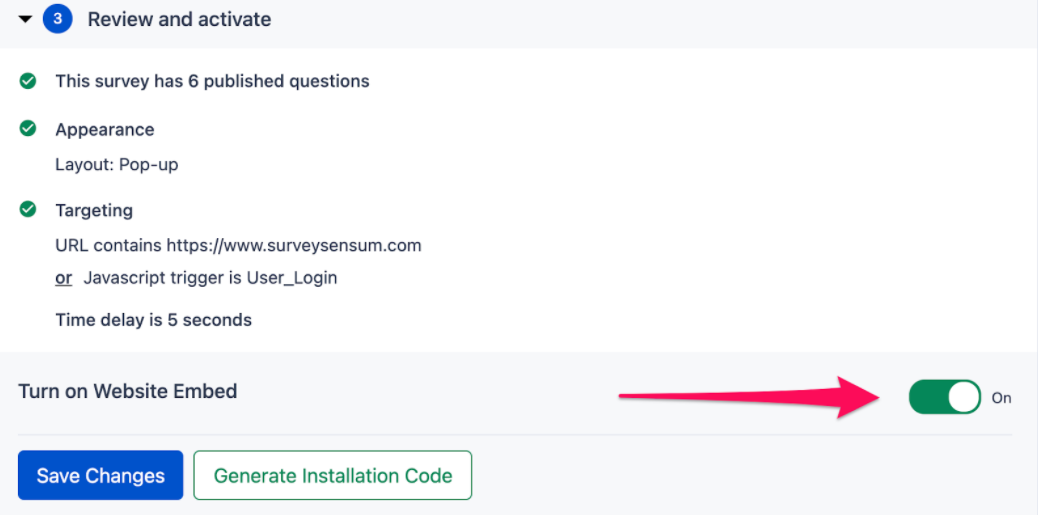
Launching & Analyzing Pop-up Surveys With SurveySensum
Popup surveys emerge as a dynamic and impactful tool for businesses aiming to gather real-time actionable insights from their customers. Sometimes these surveys might feel intrusive, but their immediate feedback, high visibility, and increased response rates make them a preferred choice in the realm of data collection. By strategically implementing popup surveys, you can engage with users in real-time, uncover valuable feedback, and make informed decisions to enhance products, services, and overall customer experience.
But to do that, you need a robust customer feedback system, like SurveySensum, to gather and analyze feedback with advanced text analytics software, take action in real-time, and close the feedback loop with dissatisfied customers in time.
Frequently Asked Questions on Pop-up Surveys
Some of the best times to trigger a pop-up survey are exit pop up surveys to understand why a user is leaving your website after a user spends a certain amount of time on a page or completes a certain action like adding items to the cart and completing a transaction.
To ensure that your pop-up surveys are not intrusive then time them thoughtfully, minimize distractions by using a clean and simple design, provide an exit option, limit the number of questions, and ask only relevant questions.
The questions you ask should align with your objectives. Here are some examples:
- For Website Feedback: “How easy was it to find what you were looking for?”
- For Product Feedback: “What features would you like us to add?”
- For Customer Support: “Was your issue resolved to your satisfaction?”
Yes, pop-up surveys can boost conversion rates when used strategically. You can improve this process by:
- Identifying navigation issues and simplifying the user journey.
- Understanding cart abandonment reasons and optimizing checkout processes.
- Collecting feedback on landing pages to make them more compelling.
Analyzing pop-up survey responses involves:
- Using text analysis tools with AI and automation to identify trends, recurring themes, and sentiments in open-ended responses.
- Leveraging analytical dashboards to visualize data and share insights with your team.
- Taking action based on insights, such as addressing frequently reported issues or enhancing popular features.
Well, pop-up surveys are quite engaging and can provide some key benefits like real-time feedback collection, improved conversion rates, enabling you to take action promptly, and it is also cost-effective in comparison to traditional feedback methods like focused group discussions, etc.













